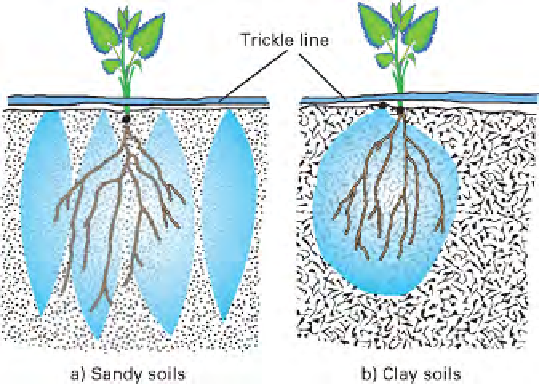Agriculture Reference
In-Depth Information
The
soil moisture deficit (SMD)
is the amount of
water needed to return the soil to field capacity.
Trickle line
For most lowland parts of Britain and Ireland, this is
roughly a month without rain in April, 20 days in May,
16 days in June and July, 20 days in August but over
60 days in September and October. If this water loss
has occurred at a time when water shortage affects
the performance of the plants involved, the 'response
periods', the soil should be returned to field capacity
in one go (so long as rain is not forecast), that is, add
50 mm water. If a sprinkler is being used, the quantity
of water added can be checked as you deliver it by
having a straight-sided container receiving the same
amount of water as the plants: switch off as the water
level comes up to 50 mm.
12
a) Sandy soils
b) Clay soils
Figure 12.16
Trickle or seep irrigation - the pattern of
water spread below the surface is shown in (a) sandy
soil and (b) clay soil. Note the dry soil at the surface
between the delivery points
Response periods
are when the plant/crop
benefits from the addition of water.
SMD reaches 25 mm. Note that 25 mm is the
equivalent to 25 mm rain which is about a third
of typical May rainfall in many parts of the SE
England. Adding 25 mm means the equivalent of
covering the whole area to be treated to a depth
of 25 mm ('an inch of rain'), which can be checked
by placing a straight-sided container within this
area. The rate of irrigation should be adjusted so
as not to exceed the infiltration rate of the soil.
Clearly irrigation should be held off if rainfall is
imminent; any extra water can be detrimental as
it leads to standing water, surface run-off and the
leaching of nutrients as well as being wasteful.
The general rule about adding water is avoid 'little
and often', which encourages shallow rooting and
maximizes water loss. Instead adopt the principles
outlined above. Hold off watering and then apply
large quantities (the soil moisture deficit but no more)
to return the soil to field capacity. An alternative
approach is to drip water close to plants that benefit
from continuous water supplies, but wet only a small
proportion of the soil surface so losses by evaporation
are minimized. The distribution of water as it soaks
in depends mainly on the soil texture with very little
spread in sandy soils, so delivery points need to be
closer together (Figure 12.16).
Irrigation plans
Methods of applying water
Soil moisture deficit (SMD) becomes important
when trying to follow an irrigation plan that
identifies how much water to add and when.
The plan should also identify the response
periods of the plant when there are benefits, that
is, when it is worthwhile adding water (after the
plants or seeds have been watered in).
A typical plan for runner beans growing on a soil
with a medium Available Water Content would
be to irrigate from early flowering onwards
(June to August) with 50 mm water when a
SMD of 50 mm had built up. Similarly, first early
potatoes grown on light, sandy soils (low AWC)
benefit from irrigation after tubers reach 10 mm
diameter (May-June) with 25 mm water when
Applying water should be carefully related to plant
requirements, climate and soil texture. The following
methods are commonly used:
X
Watering cans
are a sound choice in most gardens.
The use of 'dipping ponds' can save time waiting
for cans to be fi lled making it almost as quick as
using hoses when water is being added to small
areas or a limited number of plants. Care should be
taken to avoid damaging the crumb structure of the
soil or disturbing the growing medium in containers.
Consideration should be given to the use of fi ne
roses on cans. For watering seeds and cuttings, a
fi ne rose turned upwards is recommended in order
to minimize any disturbance by droplets.
X
Hoses fi tted with trigger lances
with means








